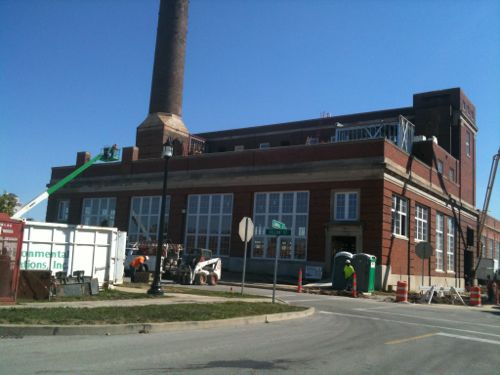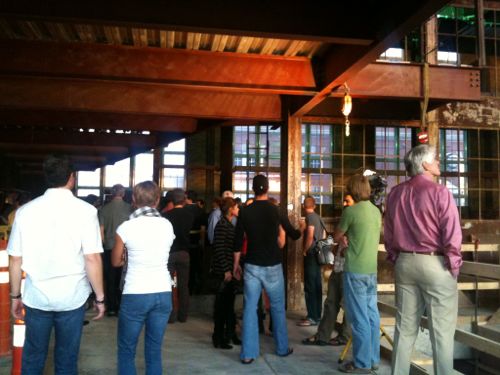Former City Hospital Power Plant to Include Rock Climbing Gym, Banquet Hall, Rooftop Dining
An interesting new concept will open for business next month:
Is St. Louis ready for one of the tallest bouldering walls in the nation? Or a banquet facility where attendees can watch rock climbers scale a 55-foot wall? Or a corporate party that includes rock climbing? Ready or not, Climb So iLL will be opening in the historic City Hospital Power Plant in mid-March. (St. Louis Business Journal)
You’ll be able to grab lunch at a restaurant while viewing the climbing space.

This is a creative  use of a difficult building:
Listed on the city’s historical registry, the Power Plant supplied power to the St. Louis City Hospital for nearly 50 years. The City Hospital complex is made up of several buildings including the Laundry Building, the Administrative Complex, the City Hospital itself, and the Power Plant.
 The once abandoned City Hospital has been renovated into the Georgian Condominiums, and the Laundry Building is now home to the Palladium Banquet Center. Several other construction projects are underway on the site. Phase two of construction hopes to bring with it a bakery, a micro-brewery, a locally-grown food processing distribution center, and a hotel. (climbsoill.com)
It has been nice seeing the City Hospital site develop over time. The streets and sidewalks have been in place and one by one the development is filling in between.

This is an example of what I was talking about the other day regarding The Bottle District — the planning was done and the infrastructure (streets & sidewalks) to connect development parcels within the site and to the adjacent neighborhoods. As demand and financing becomes available vacant buildings are renovated and occupied and new construction is built to fill in other areas.
We need more of this — plan the site, put the infrastructure in place and build/renovate over time. The developer of the site isn’t responsible for financing all the future renovations and new construction at the beginning. For more info and artist renderings of the rock climbing gym see climbsoill.com.
– Steve Patterson
I had a client that did something similar in Colorado – http://www.rocknandjamn.com/ – it’s a good use for a tough space, and I hope they can pull it off here. The two challenges I see are demand - there is already one near Union Station – http://www.upperlimits.com/ – and that they may be trying to mix two uses that really aren’t that compatible – sweaty canapes may not be the best concept, although I get why they’re trying – the space may be too big for either one individually.
I had a client that did something similar in Colorado – http://www.rocknandjamn.com/ – it’s a good use for a tough space, and I hope they can pull it off here. The two challenges I see are demand – there is already one in a similar space near Union Station – http://www.upperlimits.com/ – and that they may be trying to mix two uses that really aren’t that compatible – sweaty canapes may not be the best concept, although I get why they’re trying – the space may be too big for either one individually.
And that gets to the bigger question – how many indoor-climbing facilities, event spaces, bakeries, micro-breweries, locally-grown food processing distribution centers, and hotels can we support? Without a lot more residents and a lot more employers with good-paying jobs, it’s going to be difficult to fill all our cool, old, vacant industrial spaces with what are essentially discretionary uses, most of which pay minimum wages.
In my experience (having spent a great deal of my life living near the Canadian Rockies) climbers are a serious bunch.  They want a no bullshit uncompromising challenge when climbing.  To that end Upper Limits seems to fit the bill.  Will these folks be more likely to use a new facility with walls that look like an elephant?
Saying that, after watching the video, I get the distinct impression that climbing in the Lou seems to be a hipster activity.  To that end an artsy fartsy climbing experience would be the way to go I suppose, cater to your market….but how big is the climbing community in East/Central Missouri (hipster or otherwise)?
Don’t get me wrong I love the idea, great use for the building, we need people to takes risks like this to make the city better. However like JZ71, I wonder about viability of this project considering the (what I’m assuming to be) small market.
In my experience (having spent a great deal of my life living near the Canadian Rockies) climbers are a serious bunch. They want a no bullshit uncompromising challenge when climbing. To that end Upper Limits seems to fit the bill. Will these folks be more likely to use a new facility with walls that look like an elephant?
Saying that, after watching the video, I get the distinct impression that climbing in the Lou seems to be a hipster activity. To that end an artsy fartsy climbing experience would be the way to go I suppose, cater to your market….but how big is the climbing community in East/Central Missouri (hipster or otherwise)?
Don’t get me wrong I love the idea, great use for the building, we need people to takes risks like this to make the city better. However like JZ71, I wonder about viability of this project considering the (what I’m assuming to be) small market.
Would only agree that more residents and definitely more employers is the basis of growing or being able to sustain more businesses such as this and what is outlined in phase II. In the case of the city and specifically for this area, I think its getting more residents to return – either it be Soulard, Lafayette and hopefully more housing/infill in the immediate area. The location has great access to I-55/I-44 and only a short skip and hop away from Downtown or I-64 and therefore the multitude of employers in Clayton or West County. The reality is that most people will commute by car and it is relatively easy and quick to get around the St. Louis metro area if you have ever lived or work in other big cities/metro areas.
Would only agree that more residents and definitely more employers is the basis of growing or being able to sustain more businesses such as this and what is outlined in phase II. In the case of the city and specifically for this area, I think its getting more residents to return – either it be Soulard, Lafayette and hopefully more housing/infill in the immediate area. The location has great access to I-55/I-44 and only a short skip and hop away from Downtown or I-64 and therefore the multitude of employers in Clayton or West County. The reality is that most people will commute by car and it is relatively easy and quick to get around the St. Louis metro area if you have ever lived or work in other big cities/metro areas.
I had some friends come up with a similar idea while studying architecture at Drury University. The idea was to renovate the abandoned MFA complex west of downtown Springfield into a fitness center, using the grain silos as the location for climbing walls. This was a third year project and the complex is now owned by Missouri State Univ., but an interesting concept nonetheless.
I had some friends come up with a similar idea while studying architecture at Drury University. The idea was to renovate the abandoned MFA complex west of downtown Springfield into a fitness center, using the grain silos as the location for climbing walls. This was a third year project and the complex is now owned by Missouri State Univ., but an interesting concept nonetheless.
People coming back to Soulard and Lafeyette (Square)? These two neighborhoods GAINED population over the last ten years, these are not shrinking neighborhoods. The WORST thing about this area are the highways, not the best @ Tpreken, they split up walkable neighborhoods like Lafayette (Square), Soulard and Benton Park. Put a cap on the 55, 44 interchange, way more needed than 70 downtown.
People coming back to Soulard and Lafeyette (Square)? These two neighborhoods GAINED population over the last ten years, these are not shrinking neighborhoods. The WORST thing about this area are the highways, not the best @ Tpreken, they split up walkable neighborhoods like Lafayette (Square), Soulard and Benton Park. Put a cap on the 55, 44 interchange, way more needed than 70 downtown.
I didn’t say that Soulard and Lafayette Square was losing population or shrinknig. My point, even with the freeways and recent gains is that their is still plenty of space/infills and room for more housing stock/residential units by a long shot. Heck, their is a big empty lot just north of Old City Hospital begging for something, etc. and Lafayette Square still has plenty of space along its edges. How about west of Jefferson Ave? Yes, they are not shrinking but can still grow by a lot in terms of the number of residents an urban area can have in its defined borders. And it will take a lot to support vibrant and expanding retail such as the proposed phase II.
I didn’t say that Soulard and Lafayette Square was losing population or shrinknig. My point, even with the freeways and recent gains is that their is still plenty of space/infills and room for more housing stock/residential units by a long shot. Heck, their is a big empty lot just north of Old City Hospital begging for something, etc. and Lafayette Square still has plenty of space along its edges. How about west of Jefferson Ave? Yes, they are not shrinking but can still grow by a lot in terms of the number of residents an urban area can have in its defined borders. And it will take a lot to support vibrant and expanding retail such as the proposed phase II.Â